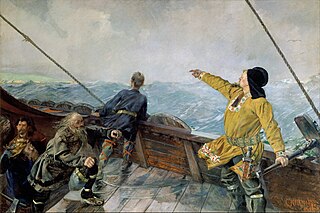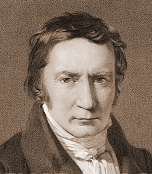Andrew Nicholas Wawn (born October 1944) is emeritus professor of Anglo-Icelandic literature at the University of Leeds and an expert on Old Norse sagas and their reception in the modern era.
Andrew Nicholas Wawn (born October 1944) is emeritus professor of Anglo-Icelandic literature at the University of Leeds and an expert on Old Norse sagas and their reception in the modern era.
Andrew Wawn was born in Wirral, [1] Cheshire, in October 1944. He attended Birkenhead School, where he cultivated an interest in golf. [2] Following a BA at the University of Birmingham, [3] he completed his PhD there in 1969 with a thesis entitled "The Plowman's Tale: Critical Edition". [4] Alongside his studies of medieval English at Birmingham, he also took part in extramural classes in Old Norse. [5]
In 1972, Wawn gained a lectureship at the University of Keele, [5] where he taught Old and Middle English, the history of the English language, stylistics, and other subjects. [6] Finding that 'það var skemmtilegra að lesa fornar íslenskar bókmenntir heldur en þær ensku' ('more entertaining to read Old Icelandic literature than English'), he began teaching Old Icelandic at Keele, and in September 1978 paid his first, week-long visit to the island, finding its autumn drizzle congenial to his temperament. [6] His research interests shifted gradually to Iceland and he became a regular visitor; his work focused on eighteenth- and nineteenth-century English visitors to Iceland, and the reception of medieval Icelandic literature in Britain. [5]
In 1983, Wawn moved to the University of Leeds, [6] building on a heritage of Icelandic studies there dating back to the interwar teaching of J. R. R. Tolkien and E. V. Gordon, and the foundation of the Bogi Melsteð Collection there. [7] At Leeds, while continuing to teach medieval English, Wawn extended his teaching from Old to Modern Icelandic, succeeding in sustaining students' interest in the subject in the face of the introduction of shorter modules, which reduced the scope for language-learning, and the attractions of other literature on an increasingly diverse syllabus. [6] [5] Wawn was promoted from senior lecturer to reader in English and Icelandic studies in 1995, [8] and subsequently to Professor of Anglo-Icelandic Studies. [3] In 2007, he was awarded the Knight’s Cross of the Icelandic Order of the Falcon for services to Icelandic studies. [7] He retired in 2009 and was made a professor emeritus. [9]
Wawn's monograph The Vikings and the Victorians: Inventing the Old North in Nineteenth-century Britain (2000) was the first book-length treatment of the reception of the Vikings in the Victorian age. [10] [11] Roberta Frank found that 'in its broad canvas and energetic research, its pace and wit and its learning lightly worn, Wawn's book is exemplary, a work of humane and original scholarship'. [12]
Wawn edited the journal Leeds Studies in English solo from 1992 to 1994, and was co-editor from 2003 to 2008. He was president of the Viking Society for Northern Research from around 2000 to 2003, and was one of editors of the Society's journal, Saga-book, around the same period. [13] In the year of his retirement, his sixty-fifth birthday was marked by the publication of a Festschrift . [14]

The sagas of Icelanders, also known as family sagas, are one genre of Icelandic sagas. They are prose narratives mostly based on historical events that mostly took place in Iceland in the ninth, tenth, and early eleventh centuries, during the so-called Saga Age. They were written in Old Icelandic, a western dialect of Old Norse. They are the best-known specimens of Icelandic literature.

Vinland, Vineland or Winland was an area of coastal North America explored by Vikings. Leif Erikson first landed there around 1000 CE, nearly five centuries before the voyages of Christopher Columbus and John Cabot. The name appears in the Vinland Sagas, and presumably describes both Newfoundland and the Gulf of Saint Lawrence as far as northeastern New Brunswick. Much of the geographical content of the sagas corresponds to present-day knowledge of transatlantic travel and North America.

Njáls saga is a thirteenth-century Icelandic saga that describes events between 960 and 1020.

Leif Erikson, Leiv Eiriksson or Leif Ericson was a Norse explorer from Iceland. He is thought to have been the first European to have set foot on continental North America, approximately half a millennium before Christopher Columbus. According to the sagas of Icelanders, he established a Norse settlement at Vinland, which is usually interpreted as being coastal North America. There is ongoing speculation that the settlement made by Leif and his crew corresponds to the remains of a Norse settlement found in Newfoundland, Canada, called L'Anse aux Meadows and which was occupied c. 1000.
In Icelandic literature, a ríma is an epic poem written in any of the so-called rímnahættir. They are rhymed, they alliterate and consist of two to four lines per stanza. The plural, rímur, is either used as an ordinary plural, denoting any two or more rímur, but is also used for more expansive works, containing more than one ríma as a whole. Thus Ólafs ríma Haraldssonar denotes an epic about Ólafr Haraldsson in one ríma, while Núma rímur are a multi-part epic on Numa Pompilius.

Flateyjarbók is an important medieval Icelandic manuscript. It is also known as Reykjavík, Stofnun Árna Magnússonar í íslenskum fræðum, GkS 1005 fol. and by the Latin name Codex Flateyensis. It was commissioned by Jón Hákonarson and produced by the priests and scribes Jón Þórðarson and Magnús Þórhallsson.

The Viking revival was a movement reflecting new interest in, and appreciation for Viking medieval history and culture. Interest was reawakened in the late 18th and 19th centuries, often with added heroic overtones typical of that Romantic era. The revival began earlier with historical discoveries and early modern publications dealing with Old Norse culture. The first printed edition of the 13th century Gesta Danorum or the Legend of the Danes by Saxo Grammaticus, came out in 1514 just as book printing began become more practical and printing trade was quickly spreading. In 1555, the Historia de gentibus septentrionalibus, or "History of the northern peoples", by Olaus Magnus was produced. The pace of publication increased during the 17th century with Latin translations of the famous Edda, notably Peder Resen's Edda Islandorum of 1665. The Edda consisted of two 13th century Medieval Icelandic literary works on Norse mythology, written down in the 13th century, but certainly from older oral sources: they are the Prose Edda, and an older collection of poems without an original title now known as the Poetic Edda. The books are the main sources of medieval skaldic tradition of poetry and storytelling in Iceland and Norse mythology.

The Vinland Sagas are two Icelandic texts written independently of each other in the early 13th century—The Saga of the Greenlanders and The Saga of Erik the Red,. The sagas were written down between 1220 and 1280, much later than the initial time of action 970–1030.

Historia de Gentibus Septentrionalibus was a monumental work by Olaus Magnus on the Nordic countries, printed in Rome 1555. It was a work which long remained for the rest of Europe the authority on Swedish matters. Its popularity increased by the numerous woodcuts of people and their customs, amazing the rest of Europe. It is still today a valuable repertory of much curious information in regard to Scandinavian customs and folklore.

Finnur Magnússon, sometimes referred to by the Danish version of his name under which he published, Finn Magnussen or Magnusen, was an Icelandic scholar and archaeologist who worked in Denmark.
The Norrœna Society was an organization dedicated to Northern European culture, that published sets of reprints of classic 19th-century editions, mostly translations, of Old Norse literary and historical works, Northern European folklore, and medieval literature. The society was founded toward the end of the 19th century and ceased publications early in the 20th century.
Strengleikar is a collection of twenty-one Old Norse prose tales based on the Old French Lais of Marie de France. It is one of the literary works commissioned by King Haakon IV of Norway for the Norwegian court, and is counted among the Old Norse Chivalric sagas. The collection is anonymous. It has been attributed to Brother Robert, a cleric who adapted several French works into Norse under Haakon, the best known of which is Tristrams saga ok Ísöndar, but there is also reason to think that the collection may be a gathering of the work of several different translators. Unlike many medieval translations, the Strengleikar are generally extremely close in sense to the Old French originals; the text which differs most is Milun, which is abridged to half its original length.
The Viking Society for Northern Research is a group dedicated to the study and promotion of the ancient culture of Scandinavia. Founded in London in 1892 as the Orkney, Shetland and Northern Society or the Viking Club, its name was changed in 1902 to the Viking Club or Society for Northern Research, and in 1912 to its present name. Its journal, Saga-Book, publication of editions, translations, and scholarly studies, and since 1964 the Dorothea Coke Memorial Lectures, have been influential in the field of Old Norse and Scandinavian-British Studies.
Eiríkr or Eiríkur Magnússon was an Icelandic scholar at the University of Cambridge, who taught Old Norse to William Morris, translated numerous Icelandic sagas into English in collaboration with him, and played an important role in the movement to study the history and literature of the Norsemen in Victorian England.
Einar Ólafur Sveinsson, often abbreviated Einar Ól. Sveinsson was an Icelandic scholar of Old Norse literature who was Professor of Icelandic Literature at the University of Iceland. His writings on and editions of sagas were particularly influential.
Sigrgarðs saga frœkna is a medieval Icelandic romance-saga, described by Finnur Jónsson as 'all in all ... one of the best and most worthy of reading' of the Icelandic 'stepmother-sagas'.
Viktors saga ok Blávus is a medieval Icelandic romance saga from the fifteenth century.
Þjalar-Jóns saga, also known as Saga Jóns Svipdagssonar ok Eireks forvitna is a medieval Icelandic saga defined variously as a romance-saga and a legendary saga. The earliest manuscript, Holm. perg. 6 4to, dates from around the first quarter of the fifteenth century, and the saga is thought to be from the fourteenth century.
Magnús Jónsson í Vigur (1637–1702) was a wealthy Icelandic landowner who is best known for his patronage of manuscripts and interest in Icelandic and foreign literature. Magnús is often referred to as Magnús í Vigur because his primary residence during his lifetime was at a farm on the small island of Vigur in Ísafjarðardjúp in the Westfjords of Iceland. He is also sometimes called Magnús digri.
Tómasarbók is a mid-sixteenth-century Icelandic manuscript. It was written between 1540 and 1560 by Ari Jónsson and his sons Jón and Tómas Arason.